Abstract
LoRa technology, renowned for its low-power, long-range capabilities in IoT applications, faces challenges in real-world scenarios, including fading channels, interference, and environmental obstacles. This paper aims to study the reliability of LoRa in Non-Line-of-Sight (NLoS) conditions and in noisy and mobile environments for Industrial IoT (IIoT) applications. Experimental measurements consider factors like vegetation and infrastructure, introducing mobility to replicate NLoS conditions. Utilizing an open-source LoRa Physical Layer (PHY) Software-Defined Radio (SDR) prototype developed with GNU Radio, we assess communication reliability through metrics such as Block Error Rate (BLER), Signal-to-Noise-Interference-plus-Noise Ratio (SINR), and data rate. The study reveals the estimated overall reliability of the LoRa signal at 90.23%, emphasizing specific configuration details. This work contributes to the broader field of LoRa communication, encompassing hardware, software, protocols, and management, enhancing our understanding of LoRa’s dependability in challenging IIoT environments.
1. Introduction
The Internet of Things (IoT) is revolutionizing industry and society worldwide, with an estimated 500 billion connected devices expected by 2030 [1,2,3]. The Industrial Internet of Things (IIoT) is a key enabler of Industry 4.0, providing ubiquitous connectivity and innovative services and applications [4]. The industrial environment is always a difficult challenge for wireless communication and wireless sensing. They present a series of constraints and difficulties that make the environment unique and different from other situations, such as offices, buildings, and indoor environments. Usually, the presence of high temperatures, excessive dust and particles, different obstacles, and metallic devices make it difficult to send data over long/medium distances at the right data rate and bandwidth [5]. Large numbers of IoT devices have been integrated into numerous specialized solutions and applications, connected by wireless Low-Power Wide-Area Network (LPWAN) technologies [6,7].
There are several competing LPWAN technologies today, adopting various techniques to achieve long-range, low-power consumption, and high scalability [8]. LPWAN networks have been designed to overcome the challenges of handling IoT and IIoT applications, enabling them to sense their surroundings, respond as required, and activate at any time to upload data to the cloud in real time [9]. LoRaWAN, a protocol in LPWAN, is widely regarded as one of the most effective and successful technologies in the field [10]. Defined by the LoRa Alliance, LoRaWAN uses the Long-Range (LoRa) physical layer to provide long-range wireless communications at low data rates and minimal power consumption, operating in unlicensed bands [11].
By 2026, LoRa will be used for more than 50% of LPWAN connections because of its adaptability for both indoor and outdoor applications [12]. It makes low-speed data transfer possible over great distances with little infrastructure and low power usage. It is employed in energy management, asset tracking, environmental monitoring, and machine monitoring applications [13]. Indeed, several issues can make implementing wireless communications in industrial settings challenging. Transmissions are altered, on the one hand, by interference brought about by signal reflection, echoes, and multipath attenuation. Multipath propagation is the outcome of these interferences, which are brought on by reflecting surfaces or obstructions. Furthermore, the interference caused by other wireless devices operating within the same frequency band also affects the overall performance of communication. Wireless communications have interfered with high noise levels produced by electromagnetic emissions from numerous industrial sources, such as large equipment, strong generators, and lasers [14,15].
In this direction, effective implementation of LoRa in IIoT applications requires careful consideration of several critical factors, including network coverage, signal strength, sources of interference, and specific data transmission requirements. To ensure optimal performance and seamless integration, it is essential to evaluate these factors in detail. Key metrics such as Signal-to-Interference-plus-Noise ratio (SINR) and Bit Error Rate (BER) are typically used to evaluate LoRa systems. The SINR plays a crucial role in determining the quality of communications, with higher values indicating stronger signals relative to interference and noise, resulting in improved data transmission efficiency and reduced errors. On the other hand, BER quantifies the accuracy of data transmission, with lower values indicating higher data reliability and quality. In the dynamic IIoT landscape, where robust communication solutions are essential to overcome interference problems, LoRa is emerging as a promising approach [16]. However, uncertainties remain regarding its performance in challenging Non-Line-of-Sight (NLoS) conditions, which are prevalent in the complex tapestry of urban environments.
Driven by a strong commitment to improving the reliability and efficiency of IIoT communications, this work explores the adaptation of LoRa technology to the particular requirements of industrial applications. At the heart of our study is a practical experiment involving a Fixed Transmitter (TX) and a Mobile Receiver (RX). The primary focus of this investigation is a comprehensive assessment of LoRa’s communication performance in challenging NLoS scenarios, which addresses a notable knowledge gap. By simulating the challenging conditions of industrial landscapes characterized by significant obstacles such as buildings and plants, our experiment aims to bridge the gap in understanding LoRa’s real-world performance in challenging environments, where reliable communication is paramount. The contributions of this paper can be summarized as follows:
- Development and analysis of an open-source prototype of a standard-compliant LoRa Physical Layer (PHY) Software-Defined Radio (SDR) based on GNU Radio.
- Simulation and evaluation of LoRa’s performance in NLoS conditions, in a noisy mobile environment, using key metrics such as BER, SINR, and data rate, demonstrating its high communication reliability for IIoT.
- Exploration and integration of the LoRa protocol into the Universal Software Radio Peripheral (USRP) for IIoT applications, leveraging the versatility of the USRP for communication system development and prototyping to provide a reliable and energy-efficient communication system capable of transmitting and receiving data over varying distances, making it suitable for industrial applications.
- A comprehensive evaluation of LoRa technology combining an open-source LoRa PHY SDR prototype, mobility, and performance metrics analysis to contribute to the knowledge base and help operators, system designers, and researchers make informed decisions about deploying wireless communication systems in industrial applications.
The rest of this paper is organized as follows: Section 2 discusses various works using LPWAN and LoRa communication technologies. Section 3 provides a detailed exploration of LoRa’s physical layer, modulation techniques, use of GNU Radio software version 3.10.7.0, and hardware implementation using USRP N321. Section 4 describes the setup designed to simulate industrial conditions. Section 5 provides a comprehensive insight into the performance of LoRa. The discussion that follows contextualizes our results and provides relevant comparisons and insights. Section 6 highlights the importance of LoRa technology in improving the reliability of IIoT communications in challenging industrial scenarios, in line with the broader context of the IIoT landscape.
2. Related Works
Several research works have been conducted in the area of LPWANs for IoT applications. Magrin et al. focus on the performance of LPWAN technology, particularly in urban scenarios [17]. Simulation results demonstrate the scalability of LPWAN networks, achieving high packet success rates even with a significant number of endpoints. Another study by Askhedkar et al. explores the use of alternative frequency bands for LPWAN transmissions, emphasizing range and data rate considerations [18]. They present a path-loss model for long-range LPWAN communications. James et al. propose an innovative public transport tracking system using wireless communication between bus stops and a central base station [19]. This system significantly reduces costs compared to conventional tracking methods and provides real-time monitoring with minimal power consumption. Sanchez-Iborra et al. explore the integration of LPWAN communications within the vehicle ecosystem [20]. Specifically, they apply LoRa technology to vehicular communications, demonstrating unprecedented ranges and opening avenues for novel services in the vehicular ecosystem.
Patel et al. delve into the experimental study of LPWAN for mobile IoT applications [21]. Their results show the impact of mobility on LPWAN performance and highlight the need for mobility-aware LPWAN protocols. Petajajarvi et al. study the coverage of LoRa LPWAN through real-world measurements [22]. Their experiments show impressive communication ranges of over 15 km over land and nearly 30 km over water and present a channel attenuation model derived from measurement data for the 868 MHz ISM band. Sobot et al. present a two-tier LPWAN system based on Unmanned Aerial Vehicle (UAV) base stations designed for dynamic deployment in remote rural environments [23]. This innovative UAV-based LPWAN network adds a layer of mobile base stations (Tier 2) to the existing macrocellular LPWAN network (Tier 1), providing connectivity to LPWAN user devices in areas without direct Tier 1 network coverage.
Abdul Razak presents a lane-change decision aid and warning system utilizing LoRa-based Vehicle-to-Vehicle (V2V) communication technology [24]. The system aims to enhance driver decision-making during lane changes on highways, providing visual and audible warnings to both host and approaching vehicle drivers. Using LoRa for V2V communication, the system offers contextual information to support safe lane-changing decisions. Soy focuses on LPWAN-based agricultural vehicle tracking using LoRa and NB-IoT technologies [25]. The study investigates coverage limits in urban, suburban, and rural environments, providing analytical expressions for maximum transmission range based on the data path-loss model. This research contributes to the development of LPWAN-based tracking systems for smart farms.
The global adoption of LoRa networks for diverse IoT applications necessitates a closer look at dense environments and the robustness of LoRa transmissions. Pham et al. focus on this concept, exploring the integration of a Carrier Sense mechanism to reduce collisions in both short and long LoRa messages [26]. Their work proposes a journey toward a Carrier Sense Multiple Access (CSMA) protocol tailored for LoRa networks, offering experimental validation through a low-cost IoT LoRa framework. The focus extends beyond theory, with practical implementation involving innovative long-range image sensor nodes. In their exploration, Benkhelifa et al. delve into LoRa waveform theory, unveiling its intricacies and establishing a comprehensive understanding [27]. They quantify orthogonality, presenting expressions in continuous- and discrete-time domains. Cross-correlation functions reveal non-orthogonality across various LoRa spreading factors, emphasizing the impact of displacement and bandwidth variation. The key finding is that LoRa modulation is inherently non-orthogonal.
Sandoval et al. enhance LoRa-based networks by optimizing transmission configurations for improved performance [28]. They introduce a bounding technique, reducing energy and time by up to 73%, enabling the derivation of individual node propagation behavior crucial for deriving optimal network-level configurations. This approach, surpassing traditional alternatives like LoRaWAN ADR, allows swift adaptation to environmental changes, resulting in a remarkable 15% performance boost. In another work, Sandoval et al. optimize the LoRa-based networks by addressing challenges in disseminating global configuration due to regional limitations on ISM bands [29]. They employ tools from the machine learning realm, formulating the updating process as a Reinforcement Learning (RL) problem. This approach results in optimal disseminating policies, enhancing per-node throughput by an impressive 147% compared to established alternatives. Tapparel et al. proposed a standard-compatible LoRa PHY Software-Defined Radio (SDR) prototype based on GNU Radio [30]. Experiments have been carried out to evaluate LoRa’s error rate for coded and uncoded cases to demonstrate that the developed open-source implementation provides a sound basis for further research. They illustrated the end-to-end experimental performance results of a LoRa SDR receiver at low SNR.
Table 1 compares the main aspects of various LPWAN and LoRa studies, providing a quick reference to identify their contributions and implications in the field of low-power, wide-area networking.

Table 1.
Exploring LPWAN landscapes: a comparative overview.
In the landscape of LPWAN research, our work on LoRa technology takes a distinct and impactful direction, addressing a crucial aspect often overlooked—reliability in NLoS conditions. While existing studies have focused on various facets, such as network scalability, propagation models, vehicular communications, and optimization techniques, our research introduces a practical dimension. Real-world experimental measurements consider environmental elements such as plants, buildings, and obstacles, providing a detailed assessment of LoRa’s performance. The innovation lies in the introduction of mobility to replicate NLoS circumstances, achieved through an open-source prototype of a LoRa physical layer Software-Defined Radio (SDR), developed using GNU Radio. This approach allows us to capture the dynamic impact of signal diffraction in realistic scenarios. Our comprehensive assessment of reliability, considering BER, SINR, and data rate, contributes to a holistic understanding of LoRa’s communication performance under challenging conditions. Beyond theoretical advancements, our work offers practical insights crucial for the real-world deployment of LoRa technology, marking a significant stride in the pursuit of robust LPWAN solutions for IoT applications.
Building upon the insights gained from these studies, Section 3 delves into the materials and methods employed in our research, with a specific focus on LoRa technology. We provide a comprehensive overview of LoRa’s modulation techniques, equations governing its performance, and the integration of the USRP N321 devices to realize our primary proposed architecture.
3. Research Methodology and Procedures
In industrial applications where seamless communication and data exchange are essential, the reliability of wireless technologies is a critical factor. Our research stems from the recognition of the challenges posed by interference to LoRa communications in industrial contexts. Inspired by a visual representation, our study is aligned with the complexities of urban navigation. Much like the interactive navigation tool shown, our research is dedicated to navigating the complex terrain of wireless communication in industrial environments.
As seen in Figure 1, the blue vehicle symbolizes mobility, reflecting the moving industrial vehicles in our study. The antenna-covered tower represents the communications infrastructure, in line with our focus on improving LoRa communications. This dynamic figure captures the essence of our research, which aims to create a concrete testbed for robust LoRa communication, even in the noisy environment typical of industrial operations. In this way, we aim to provide industry with a reliable communication capability that facilitates efficient data navigation in the complex urban environment of modern industrial applications.
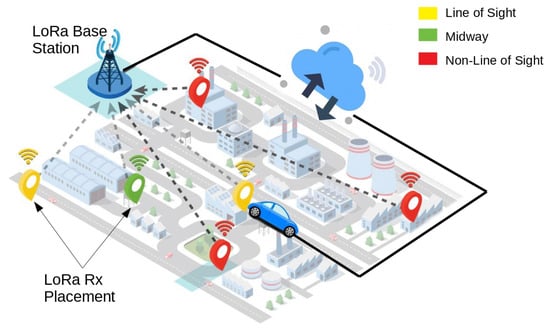
Figure 1.
Testbed for the LoRa wireless sensor node deployment.
In this paper, a LoRa-based architecture is designed to improve data communication and collection in urban environments using a simple vehicle. LoRa technology, based on the LoRaWAN protocol, has established itself as a leading wireless communication solution specifically designed to meet the needs of IoT applications. It operates in the sub-GHz frequency bands, typically at 433 MHz, 868 MHz, or 915 MHz, and offers a unique combination of long-range capabilities, low power consumption, and robustness in noisy environments. LoRa’s spread spectrum modulation techniques enable it to achieve remarkable coverage, making it well-suited to urban environments with numerous obstacles and buildings that can interfere with traditional wireless communication systems.
Urban environments present a variety of challenges for wireless communication systems. The presence of tall buildings, structures, and dense infrastructure can result in signal blockage, multipath propagation, and signal attenuation. NLoS conditions are common in urban environments and affect the reliability and range of conventional wireless technologies. This limitation is an obstacle to seamless data collection and communication in IIoT scenarios, especially for mobile platforms such as industrial vehicles navigating complex urban landscapes. The proposed architecture, shown in Figure 1, addresses the challenges posed by urban environments for wireless communication and data collection. By integrating two USRPs, one located in the moving vehicle and the other acting as a stationary transmitter, we aim to establish a reliable, direct communication link that effectively overcomes the obstacles of NLoS conditions.
The vehicle’s mobility is an advantage as it allows the USRPs to establish temporary line-of-sight connections by dynamically adjusting their antenna orientation according to the vehicle’s movement. This dynamic positioning improves the chances of successful communication between USRPs, even in NLoS scenarios caused by tall buildings and structures. In addition, this vehicle-based architecture facilitates streamlined data collection as the vehicle navigates through urban areas. It provides the means to collect up-to-the-minute data from various IoT sensors and devices strategically positioned along the vehicle’s trajectory. The architecture thus facilitates a continuous flow of information, enabling smart city applications, traffic monitoring, and environmental sensing in urban environments. The selection of SINR over Signal-to-Noise Ratio (SNR) is deliberate, aiming to provide a more accurate representation of LoRa system performance in Industrial IoT under NLoS conditions. SINR’s consideration of interference aligns with the challenges posed by industrial environments, where various electronic devices can impact signal quality. Additionally, we opted for Block Error Rate (BLER) over BER to evaluate the reliability of data transmission at the packet level, recognizing the practical importance of assessing entire data blocks in IIoT applications. The exclusion of Packet Error Rate (PER) stems from its limited granularity in understanding error severity within packets. The combined use of SINR and BLER offers a holistic evaluation, emphasizing robustness and reliability in challenging scenarios. This approach provides practical insights into the specific challenges faced by LoRa systems in Industrial IoT applications, ensuring a focused and comprehensive assessment of their performance under real-world conditions.
This flowchart Figure 2 illustrates the comprehensive process of optimizing LoRa connectivity in urban environments, from testbed implementation to careful evaluation of system performance.
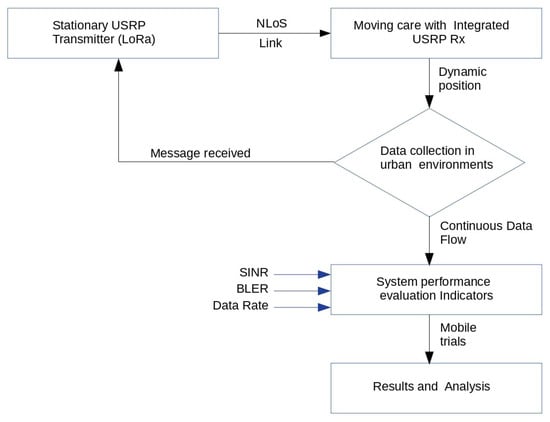
Figure 2.
Implementing the LoRa connectivity in urban environments.
3.1. Technical Specifications and Core Concepts of LoRa Technology
Setting a number of PHY variables, including Bandwidth (BW), Spreading Factor (SF), Coding Rate (CR), Transmit Power (TP), and Carrier Frequency (CF) are the primary specifications for configuring a LoRa device. Table 2 shows the LoRa configuration parameters. SF is the number of symbols per payload bit, ranging from 7 to 12. In exchange for superior sensitivity and range, a higher applied SF results in a lower data rate, longer propagation time, and higher power consumption. As a result, devices further away from the gateway require a larger SF due to the increased link budget requirement, which increases the processing gain but reduces the data rate. In addition, since SFs are orthogonal (basically quasi-orthogonal [31]), different SFs can be used to modulate different signals in the same channel. The BW is usually 125, 250, and 500 kHz in frequency.

Table 2.
LoRa parameters description.
A higher number provides more security at the cost of longer transmission times, while the CR, which represents the rate of the Forward Error Correction (FEC) code, can be set to 4/5, 4/6, 4/7, or 4/8. The LoRa modulation bit rate can then be set using Equation (1).
In addition, different parts of the LoRa spectrum have different multi-frequency channels, with CF being the center frequency of these channels. The hardware of a LoRa radio imposes limits on its Transmit Power (TP), which is typically in the range of 2 to 20 dBm [32].
The CF is also adjustable and programmable from 137 MHz to 1020 MHz in steps of 61 Hz. This range may be limited between 860 MHz and 1020 MHz depending on the LoRa chip. A higher CR provides more protection, but the time on air is longer, including an explicit header that allows radios with different CRs (but the same CF, SF, and BW) to still interact with each other. This is possible because the packet header, which is always encoded at CR 4/8, contains information about the CR of the payload.
Chirp, which stands for “Compressed High-Intensity Radar Pulse”, is a technology used in both sonar and radar systems. Chirp signals are characterized by their changing frequency at a constant amplitude. They are referred to as “up-chirps”, when the frequency increases from the lowest to the highest point, and “down-chirps’, when the frequency decreases from the highest to the lowest point. This unique spectral characteristic allows the Chirp Spread Spectrum (CSS) to transmit information efficiently. The reduced spectral efficiency inherently provides resistance to frequency-selective noise and interference from other devices. In addition, with appropriate precautions, CSS can be more resilient to multipath and Doppler effects than other conventional modulation techniques. In the context of LoRa modulation, the initial frequency of a chirp serves as the symbol.
SF is a critical parameter that determines the number of bits encoded in a symbol. Essentially, a chirp using SF represents 2 SF bits per symbol, where a symbol is represented by multiple chips in a spread spectrum code pulse, often using a Pseudo-Noise (PN) code sequence. SF is defined in Equation (2).
CSS spreads the energy of the signal over a wider band and the symbol time (Ts) is determined by the spreading factor of the transmission, as described by Equation (3).
BW stands for the signal bandwidth. An increase in the spreading factor lengthens the symbol duration, enhancing resistance to noise and interference. However, this effect can be offset by the higher likelihood of symbol errors with greater spreading factors, emphasizing the importance of receiver-to-signal synchronization, especially for small data bits. Additionally, longer message transmission increases the risk of collisions.
SF also impacts the receiver’s Sensitivity (S), defined in Equation (4):
where −174 accounts for receiver thermal noise at 1 Hz bandwidth, NF represents additional receiver noise, and SNR is the signal-to-noise ratio required for modulation. A LoRa packet structure is commonly used and includes an 8-base up-chirp preamble, a 2-base up-chirp synchronization word, a 2.25-base down-chirp start of frame delimiter (SFD), and payload data, followed by a Cyclic Redundancy Check (CRC). In LoRa modulation, the frequency of the chirps continuously varies linearly with time within the limited bandwidth available. A base up-chirp is specifically defined as a signal that sweeps linearly from its initial frequency of BW/2 to BW/2, written as [33]:
Each bit of the payload is represented by several chirps with a shifted start frequency during the LoRa modulation process, and the signal of a symbol is described in Equation (6).
When it comes to demodulation, the receiver executes the “de-chirp” operation, which multiplies each received symbol by the conjugate of a base up-chirp, or as in Equation (7), resulting in a tone of a single frequency.
The receiver then applies a Fast Fourier Transform (FFT) to the multiplication result, with the resulting peak representing the original frequency .
In this section, the importance of using the GNU Radio in the experiments is highlighted. In addition, the software aspect of our methodology is introduced. Moreover, some insights about the interaction with the GNU Radio, the used modules and their configuration as well as the software interface help us to check and test LoRa communication protocols.
The first step of the proposed process is to optimize the LoRa research environment by considering the GNU Radio software interface. The second step consists of Hardware Setup (SDR), including the SDR devices, antennas, and specialized hardware. This setup is considered the main key of our research, which ensures accurate data acquisition and transmission, and provides a comprehensive view to explore the LoRa technology.
3.2. Building the LoRa Research Environment: GNU Radio Software and Hardware Setup (SDR)
The used GNU Radio Software interface is described in detail in this section. The role of this versatile open-source toolkit used in our experimental methodology is highlighted. Moreover, we present the interaction with GNU Radio, the specifically used modules, and their settings. We show how this software interface can be used to efficiently simulate and test LoRa communication protocols.
3.2.1. GNU Radio Interface
As shown in Figure 3 and Figure 4, the transmitter and receiver chains also perform some additional processing. Before chirp modulation, the LoRa transmitter chain performs whitening, Hamming coding, interleaving, and gray mapping [30]. The receiver performs de-interlacing, Hamming decoding, de-whitening, and gray de-mapping.

Figure 3.
GNU Radio interface for the transmitter.

Figure 4.
GNU Radio interface for the receiver.
The basic whitening matrix we discovered is the one corresponding to the coding rate, CR = 4/8. The rightmost one and two columns of the basic whitening matrix are eliminated for CR = 4/7 and CR = 4/6, respectively. The last column in the whitening matrix is different from the fifth column in the basic whitening matrix when CR = 4/5. This is because, as will be shown later, a single parity check is used instead of a Hamming code for CR = 4/5. The Hamming code is error-correcting, so it should be able to correct errors by including extra words in each code word. The Hamming coding described in the patent can only be a variant of the regular Hamming coding because it can be done for coding rates of 4/8 and 4/7, but not for the others. As long as the exact composition of each code word remained unknown, the bit position within each code word was unknown.
A symbol can be distorted during transmission by noise or fading, resulting in many bit errors after demodulation. All the errors are caused by the same symbol, so they are all closely related. The problem with this is that error correction codes—which are designed to repair random errors in code words—do not deal with them effectively. The idea is to break the link between the wrong bit and the right bit by spreading the errors over many code words. This is achieved by spreading the bits of a code word over many LoRa symbols.
Any mapping of a symbol in a numerical representation to a binary sequence is known as gray encoding. The unique feature of the resulting binary sequence is that successive symbols with the same gray representation in the original format differ by only one bit. Gray codes are particularly useful in wireless communications modulation, where it is more likely that signals from nearby sources will be confused with those from random sources.
3.2.2. Hardware Setup (SDR)
Nevertheless, researchers have conducted performance and reliability studies using readily available off-the-shelf LoRa transceivers. A drawback of this approach is that it limits the ability to evaluate modifications to the LoRa physical layer or the implementation of more robust receive algorithms, as these aspects are typically fixed and predefined in commercial transceivers. A comprehensive implementation of the LoRa physical layer can be effectively addressed using software-defined radios. The LoRa PHY has been extensively reverse engineered over the last few years, and the associated SDR implementations have revealed many important aspects. Wireless communication infrastructure can benefit from flexible, scalable, and durable radio equipment thanks to SDR [34].
The SDR can also provide end users with more adaptable and potentially cheaper multistandard interfaces. This is a fundamental, practical technology for the next class of cognitive radios, i.e., context-aware, adaptive, and learning radios [35]. In this paper, we have used the USRP N321 [36]. It is a distributed, networked, software-defined radio that provides fault tolerance and reliability for use in large-scale wireless networks. This high-performance SDR offers two receiver (RX) and two transmitter (TX) channels in a half-width RU form factor, thanks to an original RF design. Each channel has an extended frequency range from 3 MHz to 6 GHz and can instantly deliver up to 200 MHz of bandwidth. Phase-coherent MIMO testbeds can be implemented thanks to a versatile synchronization architecture that supports a 10 MHz clock reference, a Pulse-per-Second (PPS) time reference, external TX and RX Local Oscillator (LO) inputs, and a GPS Disciplined Oscillator (GPSDO). With the unique ability to remotely manage activities such as debugging, software upgrades, reboots, factory resets, and system health monitoring, the USRP N321 utilizes today’s USRP Hardware Driver (UHD) software advances to simplify the administration and management of multiple devices over the network.
In the following section, “Experimental and Real-World Implementation”, we delve into the practical aspects of our study, where we put our methodology to work and demonstrate the real-world application of LoRa technology.
4. Experimental and Real-World Implementation
In this testbed implementation, numerous metrics, including SINR, BLER, and data rate, are taken into account when evaluating system performance. Our LoRa algorithm is built using open-source software. Two USRP N321 devices, one used as a transmitter and the other as a receiver.
As shown in Figure 5, the USRP oscillator uses the GPS antenna as a timing reference, enabling precise time synchronization for signal identification. The USRP oscillators use the GPS antenna as a timing reference, enabling precise time synchronization for signal identification. Vehicle-mounted unidirectional antennas are employed, with the center frequency set at 169.7 MHz. During the mobile trials, the USRP and PC are both powered by an uninterruptible power source, and the PC is connected to the USRP through a 10 Gigabit Ethernet connection. There were two phases to this implementation: stationary and mobile. To determine a specific SINR value for LoRa, the stationary USRP N321, including the Key Performance Indicator (KPI) outcomes, is mostly used as a reference.
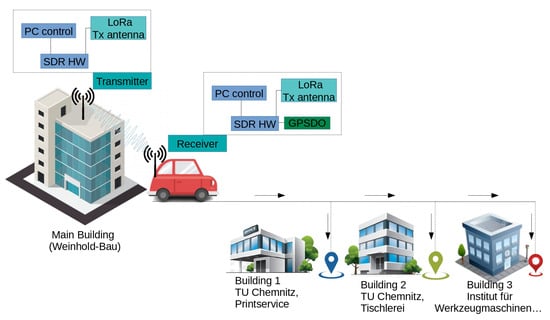
Figure 5.
Testbed scenario.
The selection of USRP N321 devices of LoRa in IIoT under NLoS conditions is driven by their superior configurability and capabilities. These devices offer precise control over radio parameters, allowing detailed analysis of communication protocols. With a wide frequency range, they simulate diverse industrial environments accurately. While Arduino and STM32 are cost-effective, they lack the processing power for in-depth signal analysis. Raspberry Pi provides more processing power, but may have higher power consumption. The USRP N321, with its real-time capabilities and specialized focus on software-defined radio research, aligns with our need for accurate and detailed data collection in exploring the nuances of LoRa communication in industrial settings. If the received signal power is less than −93 dBm, the LoRa receiver will not be able to synchronize with the transmitted signal. Buildings with glass higher than 20 m and surrounding the 300 m NLoS communication area of the mobile can result in high reflection coefficients, shadowing, and multipath. The LoRa parameters are shown in Table 3. For optimum performance, CR = 4/6 and SF = 10 are used. BW = 200 kHz and a sample rate of 240 kHz are also considered to improve SINR and signal coverage.

Table 3.
LoRa parameters of the testbed.
Figure 6 illustrates the investigation carried out at the Chemnitz University of Technology, Germany, with particular reference to the impact of buildings on NLoS communications. The figure includes a map illustrating the measured path. It shows the positions where the signal strength measurements were taken, highlighting the areas influenced by buildings with glass higher than 20 m. These buildings, located within a 300 m radius of the mobile area, are important as they can introduce significant reflection coefficients.
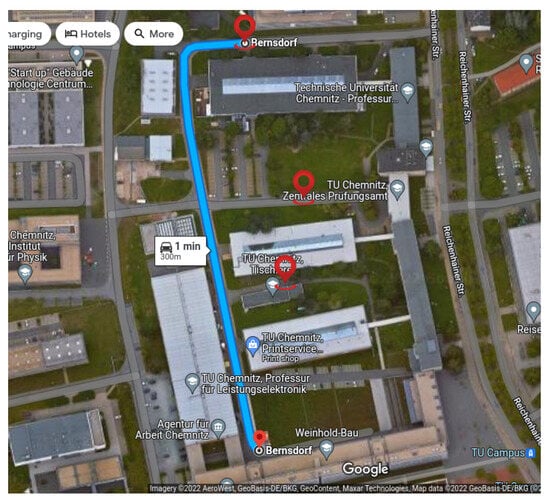
Figure 6.
Testbed scenario at Chemnitz University of Technology (Weinholdbau), campus Reichenhainerstrasse.
Figure 7 and Figure 8 show the implementation of the necessary equipment for each transmitter and receiver in the car and on the roof of the Weinhold Building at Chemnitz University of Technology. The transmitter has already started transmitting LoRa signals and the car is ready to start the measurements. The results of this training are noted in the next section of this article.
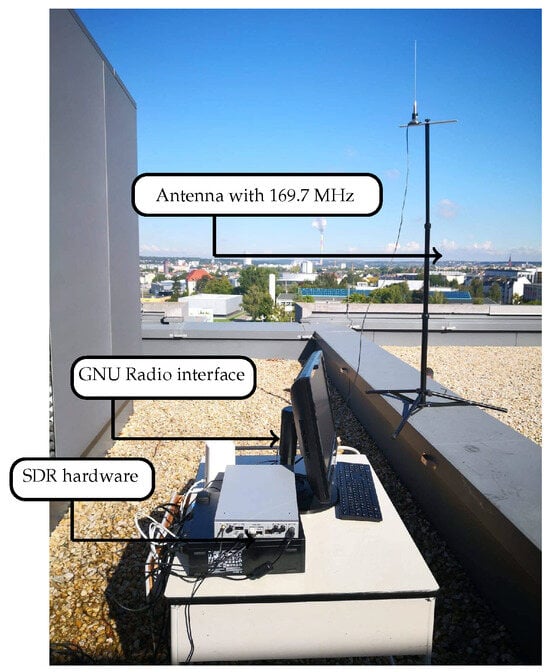
Figure 7.
Transmitter side.
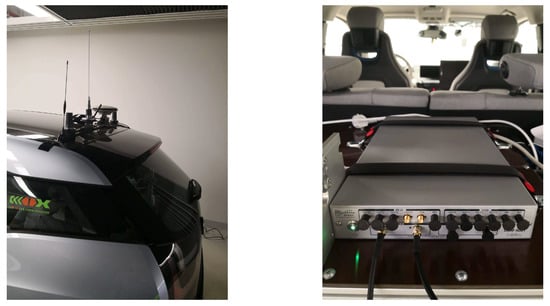
Figure 8.
Receiver side.
5. Results and Discussion
The following section presents the results and discussion of the performance of LoRa connectivity during a vehicle journey along a predefined route. This analysis focuses on key metrics such as SINR and BLER values and data rates and highlights the challenges and successes encountered during the experiment.
5.1. SINR Analysis
Figure 9 and Figure 10 show the SINR values of the LoRa link as our research vehicle travels along the predetermined route. Figure 9 shows that the SINR values have dropped rapidly to below 40 dB as the signal passes through the container where it is diffracted. As we can see, the LoRa receiver successfully decoded the data over most of the specified distance. With a standard deviation of 7.95, the overall average LoRa SINR achieved, covering the entire specified path, is equivalent to 27.80 dB, as shown in Figure 10. The weak signal and spotty coverage were responsible for the subsequent drop in performance. The path of the main diffracted signal includes trucks, containers, and natural obstructions, in addition to the main buildings. There is also a significant gap between the transmitter and the receivers.
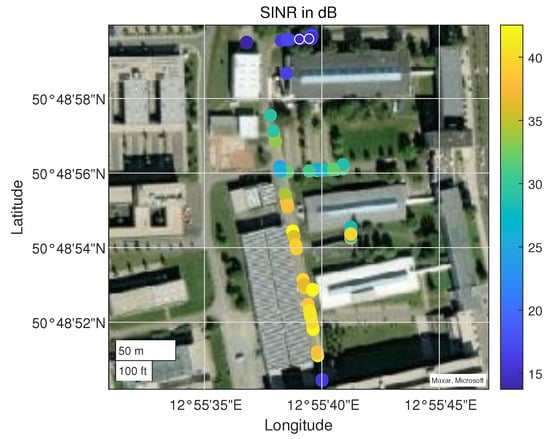
Figure 9.
LoRa SINR results, measured while the vehicle is moving across the defined path.
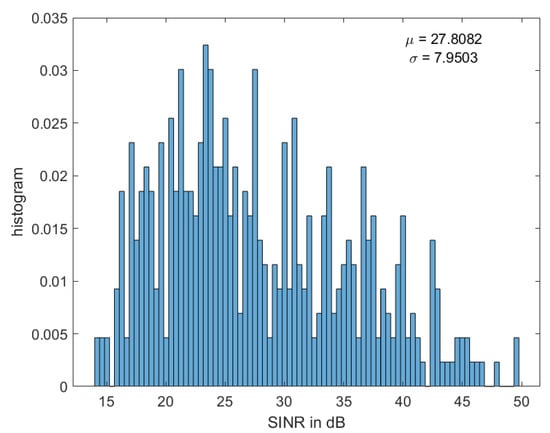
Figure 10.
LoRa SINR histogram measured while the vehicle is moving across the defined path.
The color bar to the right of the plot in Figure 9 shows the values of each point shown on the map. The purple points with white outlines on the map describe the loss of connectivity at the receiver end.
5.2. BLER Analysis
In our study of BLER, we observed trends in LoRa link performance. Figure 11 clearly shows that LoRa’s BLER hovers around 5 dB when interference is introduced into the environment. This observation highlights the sensitivity of the system to external factors and prompts a deeper investigation into its resilience.
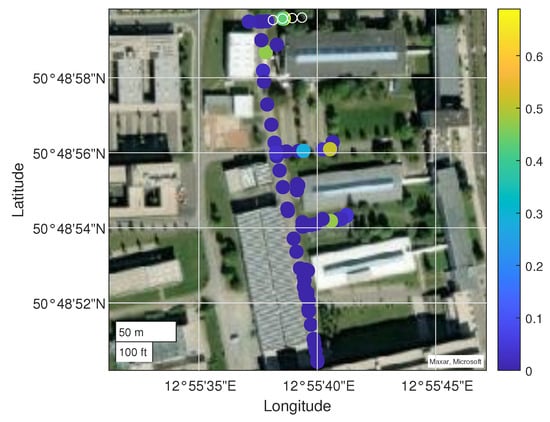
Figure 11.
LoRa BLER results, measured while the vehicle is moving across the defined path.
In addition, Figure 12 provides critical insight by showing that the overall BLER, as estimated by LoRa, remains at a remarkably low value of 4%. This finding is indicative of the robustness of the system in maintaining data integrity under typical operating conditions. However, it is important to highlight a significant aspect of our analysis: in certain locations where the calculated SINR dropped below 15 dB, the BLER calculations showed a significant increase, approaching an alarming 45%. This divergence in BLER values underlines the key role that SINR plays in determining the error rate of the system and highlights the need for strategies to mitigate BLER peaks in areas of weaker signal strength.
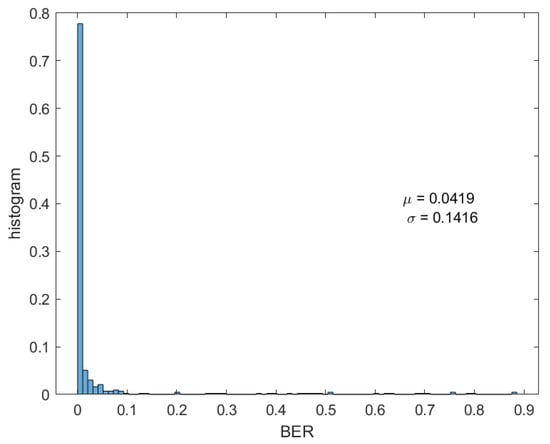
Figure 12.
LoRa BLER histogram.
5.3. Data Rate Analysis
Figure 13 and Figure 14 provide a comprehensive view of the calculated data rates for LoRa technology in our experimental setup. Notably, in this particular configuration, we found that data rate was not as important as reliability in assessing LoRa performance. Instead, our investigation focused on understanding the complex interplay between signal strength and data transmission.
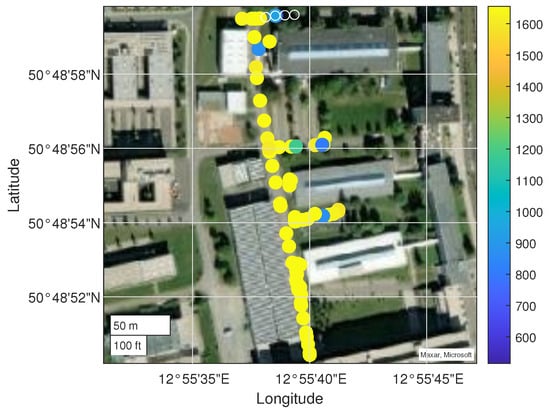
Figure 13.
LoRa data rate results, measured while the vehicle is moving across the defined path.
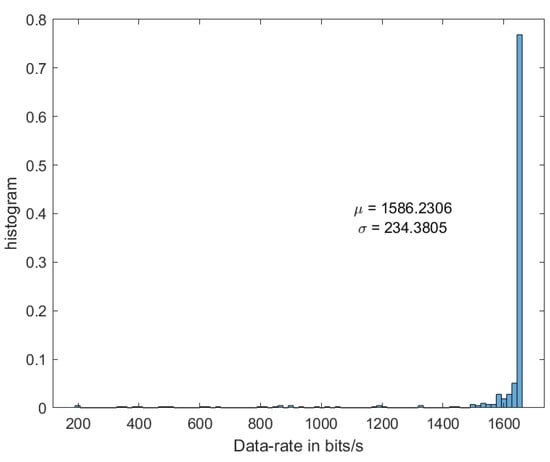
Figure 14.
LoRa data rate histogram.
In our real-world example, the LoRa signal was subjected to extreme conditions, with signal diffraction occurring just 1 m from the transmitter to the moving vehicle. This proximity to a signal diffraction point was a significant challenge and provided a unique test bed for LoRa’s capabilities. The results provided a compelling insight: Despite these challenging circumstances, the LoRa link demonstrated remarkable resilience, maintaining an average data rate of 1.58 kbps over the entire designated route. This performance underscores the adaptability and effectiveness of LoRa technology in maintaining communications even under adverse signal propagation conditions. In this configuration, data rate is not as critical to LoRa performance as reliability.
In our example, the signal is subjected to extreme conditions, where signal diffraction occurs just 1 m from the transmitter to the vehicle. According to the results, a LoRa link was able to transmit data at an average rate of 1.58 kbps while covering the entire designated route.
The primary aim of this study was to assess the performance of LoRa in NLoS scenarios for IIoT applications, and the results directly address this objective. Through careful selection of test parameters and a comprehensive analysis of key metrics, including SINR, BLER, and data rate, we have provided detailed insights into LoRa’s behavior under challenging industrial conditions. Furthermore, our study goes beyond conventional assessments, demonstrating the technical sophistication and innovation embedded in our experimental design. By revealing a deep understanding of LoRa’s performance across various environments, our findings contribute new insights to the existing body of knowledge. For instance, the study identifies specific parameters and configurations that optimize LoRa’s reliability in industrial contexts, offering practical applications for enhancing wireless communication in IIoT scenarios. The relevance and applicability of our results are evident in their potential to influence both theoretical understanding and practical implementations in IIoT communications. Our research not only reaffirms the robustness and effectiveness of LoRa in IIoT scenarios, but also highlights its innovative features in handling high levels of interference without significant performance degradation. This has broader implications for the field, suggesting that LoRa, with its adaptive mechanisms and resilient signal strength, can be a pivotal technology in addressing communication challenges in industrial settings.
5.4. Discussion
Figure 15 shows the two results, data rate and BLER reporting the SINR. For maximum sensitivity, SINR equal to −20 dB, LoRa achieves 0.62 Kbps for data rate and 1 for BLER. The data rate is 1.34 kbps at −15 dB with a BLER of 50%. LoRa can operate at its highest data rate and BLER when the SINR is 5 dB or higher.
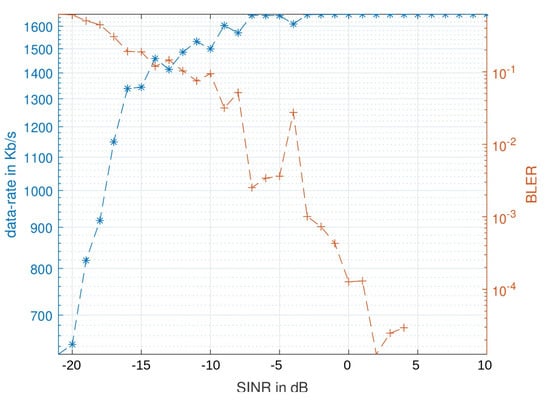
Figure 15.
LoRa data rate, BLER and SINR results.
Table 4 shows measurements of SINR, BLER, and data rate at various distances between the RX and TX in a LoRa protocol trial where the TX was stationary on the roof of a university building and the RX was mounted on a moving car. The results show that the performance of the LoRa protocol is affected by the distance between the RX and TX, with increasing distance leading to a decrease in SINR and data rate and an increase in BLER.

Table 4.
Analysis of LoRa protocol performance with a moving receiver.
Investigating LoRa in a software-defined radio-enhanced mobile receiver configuration for IIoT applications has shown some interesting results, as outlined in the previous sections. We observe from the obtained results that increasing the distance between the transmitter and receiver decreases the data rates. This drop is to be expected, because signal strength decreases with distance, which leads to higher transmission errors and, consequently, lower data rates. However, it should be noted that at certain distances, data rates have fallen even more than expected. A further significant observation is the effect of distance on SINR and BLER, which are dependent on SNR. By increasing the distance, the signal strength decreases, leading to a lower SNR. Consequently, there is a reduction in SINR and an increase in BLER. Our results clearly show that LoRa demonstrates remarkable reliability in different positions while maintaining high signal strength. In summary, the results of this research indicate that LoRa shows significant promise for IIoT applications, with the possibility of further enhancement with the help of SDR technology. Furthermore, the SDR can help optimize transmission parameters, such as modulation schemes and coding rates, resulting in increased data rates and system reliability.
Understanding the complex interaction of spreading factor and bandwidth is essential to optimize LoRa communication systems against interference. In our experiments, these configuration parameters have impacts on the communication range, data rate, and sensitivity to interference. Higher SF values, exemplified by SF = 10, enhance noise immunity by lengthening symbol duration, thereby facilitating better signal discrimination in noisy environments. However, this advantage comes at the cost of reduced data throughput, causing a delicate balance between noise robustness and the data throughput required for specific applications. Likewise, choosing a BW, such as BW = 200 kHz, can lead to a trade-off. A narrower bandwidth can improve the noise immunity to narrowband interference but may increase susceptibility to narrowband interference. The strategic combination of SF = 10 and BW = 200 kHz appears to be a nuanced approach to improve noise resilience, especially in narrowband noise environments. This combination takes advantage of the extended symbol duration to improve interference rejection, while the narrower bandwidth focuses on specific frequency bands, minimizing the impact of narrowband interference. These considerations provide actionable insights for optimizing LoRa installations and aligning system performance with the requirements of IIoT applications, where resistance interference is paramount.
The investigation into LoRa in a software-defined radio-enhanced mobile receiver configuration for IIoT applications provides valuable insights into system performance across distance, SINR, BLER, and data rates. The study’s findings serve as a foundation for enhancing LoRa system performance in industrial contexts. By optimizing communication parameters, such as spreading factor and bandwidth, tailored to specific environmental conditions, LoRa proves more reliable. Its ability to resist interference through adaptive mechanisms ensures consistent performance in dynamic industrial settings. The customization of LoRa protocols for different industrial landscapes, coupled with energy-efficient strategies, underscores its suitability for applications like smart agriculture or manufacturing. Additionally, the study affirms LoRa’s resilience in NLoS environments, making it ideal for scenarios where traditional communication networks may face limitations, such as large warehouses with complex layouts. Overall, these findings provide actionable insights for refining LoRa systems, improving their relevance, and addressing the unique challenges presented by diverse industrial contexts. Moreover, the integration of SDR technology holds the potential for fine-tuning transmission parameters, modulation schemes, and coding rates, thereby increasing data rates and bolstering overall system reliability. The strategic configuration of spreading factor and bandwidth proves crucial for optimizing LoRa against interference, offering actionable insights for real-world implementations. As the landscape of IoT and Industrial IoT evolves, continual exploration and refinement of LoRa technology will play a pivotal role in shaping its future capabilities.
To conclude, exploring LoRa in a mobile RX environment, along with SDR, provides valuable information on the system’s performance in terms of distance, SINR, BLER, and data rates. This knowledge can be used as a basis for optimizing the system and improving its relevance to IIoT applications in various industrial contexts. In envisioning the future trajectory of LoRa technology, our study opens avenues for potential advancements and optimizations. One promising avenue is the integration of the SDR technology to enhance the system performance. By leveraging the flexibility of SDR, future implementations could explore fine-tuning transmission parameters, modulation schemes, and coding rates. This approach holds the potential for increasing data rates and bolstering overall system reliability. Additionally, exploring adaptive mechanisms based on real-time environmental conditions could be a promising avenue for further research. As the landscape of IoT and Industrial IoT continues to evolve, continual exploration and refinement of LoRa technology will play a pivotal role in shaping its future capabilities.
6. Conclusions
Industrial IoT applications require wireless communications solutions that not only meet reliability requirements but also demonstrate innovation and technical prowess, especially in harsh environments. In this paper, we examine the performance of LoRa in such high-interference IIoT scenarios, aiming to uncover new insights and demonstrate technical depth. Through careful selection of test parameters and comprehensive analysis of key metrics including SINR, BLER, and data rate, we revealed a deep understanding of LoRa’s performance across environments. Our exploration of LoRa technology in high-interference IIoT scenarios not only reaffirms its proven reliability but also sheds light on its theoretical and practical implications, positioning it as an innovative solution. The theoretical consequences of our study extend to the broader landscape of IIoT communications, emphasizing the pivotal role of LoRa in addressing challenges posed by harsh industrial environments. The robustness of LoRa’s NLoS conditions distinguishes it from alternative networks, exemplifying its resilience against obstructions and interference. This resilience, coupled with its efficient control over transmission parameters, places LoRa in direct competition with other communication protocols in IIoT applications. The practical consequences of our findings suggest that LoRa stands out as a strong contender in the IIoT realm, offering a technically advanced and cost-effective wireless communications solution. Future research endeavors should explore the integration of LoRa alongside other communication protocols, examining how its unique strengths can complement or surpass those of existing solutions in addressing the specific challenges posed by industrial environments. As future work, the proposed solution will be implemented in different diverse industrial fields. Moreover, a comparative analysis with alternative wireless communication solutions will be performed.
Author Contributions
B.A. contributed by the experiment, measurement, manuscript concept, methodology, original draft writing, visualization, and editing; S.K. and R.C. contributed with the manuscript concept, methodology, original draft writing, editing, and reviewing; C.L. contributed with measurement; K.M. and O.K. contributed by methodology, reviewing, visualization, and editing. All authors have read and agreed to the published version of the manuscript.
Funding
This manuscript was funded by the “Wandel durch Innovation in der Region (WIR)!—Change through Innovation in the Region” program implemented by the Smart Rail Connectivity Campus (SRCC) within the research project “Train Integrity Monitoring System (TIMS)” (FKZ 03WIR1206A).
Institutional Review Board Statement
Not applicable.
Informed Consent Statement
Not applicable.
Data Availability Statement
The data presented in this study are available on request from the corresponding author.
Conflicts of Interest
The authors declare no conflicts of interest.
Abbreviations
The following abbreviations are used in this manuscript:
| ADR | Adaptive Data Rate |
| BER | Bit Error Rate |
| BLER | Block Error Rate |
| BW | Bandwidth |
| CF | Carrier Frequency |
| CR | Coding Rate |
| CSMA | Carrier Sense Multiple Access |
| GNU | GNU’s Not Unix! |
| IoT | Internet of Things |
| IIoT | Industrial Internet of Things |
| ISM | Industrial, Scientific and Medical |
| LoRa | Long Range |
| LoS | Line-of-Sight |
| LPWAN | Low-Power Wide-Area Network |
| NB-IoT | Narrowband IoT |
| NLoS | Non-Line-of-sight |
| PHY | Physical Layer |
| RX | Receiver |
| SDR | Software-Defined-Radio |
| SF | Spreading Factor |
| SINR | Signal-to-Noise-Interference-plus-Noise Ratio |
| TP | Transmit Power |
| TX | Transmitter |
| UAV | Unmanned Aerial Vehicle |
| USRP | Universal Software Radio Peripheral |
| V2V | Vehicle-to-Vehicle |
| WSN | Wireless Sensor Network |
References
- De Nardis, L.; Mohammadpour, A.; Caso, G.; Ali, U.; Di Benedetto, M.G. Internet of things platforms for academic Research and Development: A critical review. Appl. Sci. 2022, 12, 2172. [Google Scholar] [CrossRef]
- Wójcicki, K.; Biegańska, M.; Paliwoda, B.; Górna, J. Internet of Things in Industry: Research Profiling, Application, Challenges and Opportunities—A Review. Energies 2022, 15, 1806. [Google Scholar] [CrossRef]
- Kanoun, O.; Bouattour, G.; Khriji, S.; Hamza, K.; Adawy, A.; Bradai, S. Sustainable Wireless Sensor Networks for Railway Systems Powered by Energy Harvesting from Vibration. IEEE Instrum. Meas. Mag. 2023, 26, 33–38. [Google Scholar] [CrossRef]
- Kanoun, O.; Khriji, S.; Naifar, S.; Bradai, S.; Bouattour, G.; Bouhamed, A.; El Houssaini, D.; Viehweger, C. Prospects of wireless energy-aware sensors for smart factories in the industry 4.0 era. Electronics 2021, 10, 2929. [Google Scholar] [CrossRef]
- Tessaro, L.; Raffaldi, C.; Rossi, M.; Brunelli, D. LoRa performance in short range industrial applications. In Proceedings of the 2018 International Symposium on Power Electronics, Electrical Drives, Automation and Motion (SPEEDAM), IEEE, Amalfi, Italy, 20–22 June 2018; pp. 1089–1094. [Google Scholar]
- Piechowiak, M.; Zwierzykowski, P.; Musznicki, B. LoRaWAN Metering Infrastructure Planning in Smart Cities. Appl. Sci. 2023, 13, 8431. [Google Scholar] [CrossRef]
- Leonardi, L.; Lo Bello, L.; Patti, G.; Pirri, A.; Pirri, M. Combined Use of LoRaWAN Medium Access Control Protocols for IoT Applications. Appl. Sci. 2023, 13, 2341. [Google Scholar] [CrossRef]
- Leonardi, L.; Battaglia, F.; Patti, G.; Bello, L.L. Industrial LoRa: A novel medium access strategy for LoRa in industry 4.0 applications. In Proceedings of the IECON 2018—44th Annual Conference of the IEEE Industrial Electronics Society, IEEE, Washington, DC, USA, 21–23 October 2018; pp. 4141–4146. [Google Scholar]
- Chéour, R.; Khriji, S.; Abid, M.; Kanoun, O. Microcontrollers for IoT: Optimizations, Computing Paradigms, and Future Directions. In Proceedings of the 2020 IEEE 6th World Forum on Internet of Things (WF-IoT), New Orleans, LA, USA, 2–16 June 2020; pp. 1–7. [Google Scholar] [CrossRef]
- Leonardi, L.; Bello, L.L.; Patti, G. MRT-LoRa: A multi-hop real-time communication protocol for industrial IoT applications over LoRa networks. Comput. Commun. 2023, 199, 72–86. [Google Scholar] [CrossRef]
- Khriji, S.; Günyeli, Ö.K.; El Houssaini, D.; Kanoun, O. Energy-Efficient Short-Long Range Communication Network Combining LoRa and Low-Power Radio for Large-Scale IoT Applications. In Proceedings of the 2022 IEEE 9th International Conference on Computational Intelligence and Virtual Environments for Measurement Systems and Applications (CIVEMSA), IEEE, Chemnitz, Germany, 15–17 June 2022; pp. 1–6. [Google Scholar]
- Fahmida, S.; Modekurthy, V.P.; Ismail, D.; Jain, A.; Saifullah, A. Real-Time Communication over LoRa Networks. In Proceedings of the 2022 IEEE/ACM Seventh International Conference on Internet-of-Things Design and Implementation (IoTDI), IEEE, Milano, Italy, 4–6 May 2022; pp. 14–27. [Google Scholar]
- Amelia, F.; Ramadhani, M.F. LoRa-Based Asset Tracking System with Data Encryption Using AES-256 Algorithm. In Proceedings of the 2022 International Conference on Radar, Antenna, Microwave, Electronics, and Telecommunications (ICRAMET), IEEE, Bandung, Indonesia, 6–7 December 2022; pp. 194–199. [Google Scholar]
- Saadaoui, S.; Tabaa, M.; Monteiro, F.; Chehaitly, M.; Dandache, A. Discrete wavelet packet transform-based industrial digital wireless communication systems. Information 2019, 10, 104. [Google Scholar] [CrossRef]
- Sv, A.; Ganesh, N.; Lekha, U.C.; Irfan, S. Industrial Parameters Monitoring with Lora Technology in next Generation Wireless Communications. Turk. J. Physiother. Rehabil. 2021, 32, 805–815. [Google Scholar]
- Peruzzi, G.; Pozzebon, A. Combining lorawan and nb-iot for edge-to-cloud low power connectivity leveraging on fog computing. Appl. Sci. 2022, 12, 1497. [Google Scholar] [CrossRef]
- Magrin, D.; Centenaro, M.; Vangelista, L. Performance evaluation of LoRa networks in a smart city scenario. In Proceedings of the 2017 IEEE International Conference on Communications (ICC), Paris, France, 21–25 May 2017; pp. 1–7. [Google Scholar] [CrossRef]
- Askhedkar, A.R.; Chaudhari, B.S.; Abdelhaq, M.; Alsaqour, R.; Saeed, R.; Zennaro, M. LoRa Communication Using TVWS Frequencies: Range and Data Rate. Future Internet 2023, 15, 270. [Google Scholar] [CrossRef]
- James, J.G.; Nair, S. Efficient, real-time tracking of public transport, using LoRaWAN and RF transceivers. In Proceedings of the TENCON 2017—2017 IEEE Region 10 Conference, Penang, Malaysia, 5–8 November 2017; pp. 2258–2261. [Google Scholar] [CrossRef]
- Sanchez-Iborra, R.; Gómez, J.S.; Santa, J.; Fernández, P.J.; Skarmeta, A.F. Integrating LP-WAN communications within the vehicular ecosystem. J. Internet Serv. Inf. Secur. 2017, 7, 45–56. [Google Scholar]
- Patel, D.; Won, M. Experimental Study on Low Power Wide Area Networks (LPWAN) for Mobile Internet of Things. In Proceedings of the 2017 IEEE 85th Vehicular Technology Conference (VTC Spring), Sydney, NSW, Australia, 4–7 June 2017; pp. 1–5. [Google Scholar] [CrossRef]
- Petajajarvi, J.; Mikhaylov, K.; Roivainen, A.; Hanninen, T.; Pettissalo, M. On the coverage of LPWANs: Range evaluation and channel attenuation model for LoRa technology. In Proceedings of the 2015 14th International Conference on ITS Telecommunications (ITST), Copenhagen, Denmark, 2–4 December 2015; pp. 55–59. [Google Scholar] [CrossRef]
- Sobot, S.; Lukic, M.; Bortnik, D.; Nikic, V.; Lima, B.; Beko, M.; Vukobratovic, D. Two-Tier UAV-based Low Power Wide Area Networks: A Testbed and Experimentation Study. In Proceedings of the 2023 6th Conference on Cloud and Internet of Things (CIoT), Lisbon, Portugal, 20–22 March 2023; pp. 85–90. [Google Scholar] [CrossRef]
- Abdul Razak, S.F.; Ren, T.; Yogarayan, S.; Kamis, N.; Yusof, I. Lane change decision aid and warning system using LoRa-based vehicle-to-vehicle communication technology. Bull. Electr. Eng. Inform. 2023, 12, 2428–2437. [Google Scholar] [CrossRef]
- Soy, H. Coverage Analysis of LoRa and NB-IoT Technologies on LPWAN-based Agricultural Vehicle Tracking Application. Sensors 2023, 23, 8859. [Google Scholar] [CrossRef]
- Pham, C. Investigating and experimenting CSMA channel access mechanisms for LoRa IoT networks. In Proceedings of the 2018 IEEE Wireless Communications and Networking Conference (WCNC), Barcelona, Spain, 15–18 April 2018; pp. 1–6. [Google Scholar] [CrossRef]
- Benkhelifa, F.; Bouazizi, Y.; McCann, J.A. How Orthogonal is LoRa Modulation? IEEE Internet Things J. 2022, 9, 19928–19944. [Google Scholar] [CrossRef]
- Sandoval, R.M.; Rodenas-Herraiz, D.; Garcia-Sanchez, A.J.; Garcia-Haro, J. Deriving and Updating Optimal Transmission Configurations for Lora Networks. IEEE Access 2020, 8, 38586–38595. [Google Scholar] [CrossRef]
- Sandoval, R.M.; Garcia-Sanchez, A.J.; Garcia-Haro, J. Optimizing and Updating LoRa Communication Parameters: A Machine Learning Approach. IEEE Trans. Netw. Serv. Manag. 2019, 16, 884–895. [Google Scholar] [CrossRef]
- Tapparel, J.; Afisiadis, O.; Mayoraz, P.; Balatsoukas-Stimming, A.; Burg, A. An open-source LoRa physical layer prototype on GNU radio. In Proceedings of the 2020 IEEE 21st International Workshop on Signal Processing Advances in Wireless Communications (SPAWC), IEEE, Atlanta, GA, USA, 26–29 May 2020; pp. 1–5. [Google Scholar]
- Kang, J.M.; Lim, D.W. On the Quasi-Orthogonality of LoRa Modulation. IEEE Internet Things J. 2023, 10, 12366–12378. [Google Scholar] [CrossRef]
- Paredes, W.D.; Kaushal, H.; Vakilinia, I.; Prodanoff, Z. LoRa Technology in Flying Ad Hoc Networks: A Survey of Challenges and Open Issues. Sensors 2023, 23, 2403. [Google Scholar] [CrossRef]
- Gkotsiopoulos, P.; Zorbas, D.; Douligeris, C. Performance determinants in LoRa networks: A literature review. IEEE Commun. Surv. Tutor. 2021, 23, 1721–1758. [Google Scholar] [CrossRef]
- Del Barrio, A.A.; Manzano, J.P.; Maroto, V.M.; Villarín, Á.; Pagán, J.; Zapater, M.; Ayala, J.; Hermida, R. HackRF+ GNU Radio: A software-defined radio to teach communication theory. Int. J. Electr. Eng. Educ. 2023, 60, 23–40. [Google Scholar] [CrossRef]
- Kafetzis, D.; Vassilaras, S.; Vardoulias, G.; Koutsopoulos, I. Software-defined networking meets software-defined radio in mobile ad hoc networks: State of the art and future directions. IEEE Access 2022, 10, 9989–10014. [Google Scholar] [CrossRef]
- Ettus Research. USRP N321 Simplyfing SDR Deployment; Ettus Research: Mountain View, CA, USA, 2023. [Google Scholar]
Disclaimer/Publisher’s Note: The statements, opinions and data contained in all publications are solely those of the individual author(s) and contributor(s) and not of MDPI and/or the editor(s). MDPI and/or the editor(s) disclaim responsibility for any injury to people or property resulting from any ideas, methods, instructions or products referred to in the content. |
© 2024 by the authors. Licensee MDPI, Basel, Switzerland. This article is an open access article distributed under the terms and conditions of the Creative Commons Attribution (CC BY) license (https://creativecommons.org/licenses/by/4.0/).